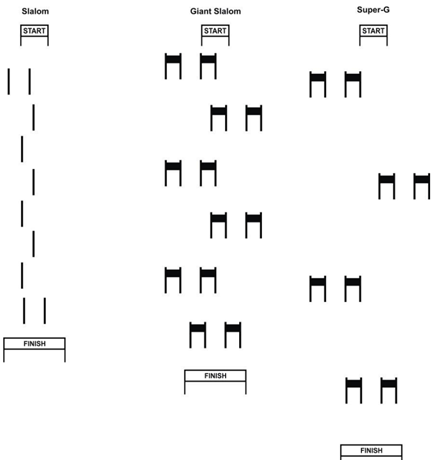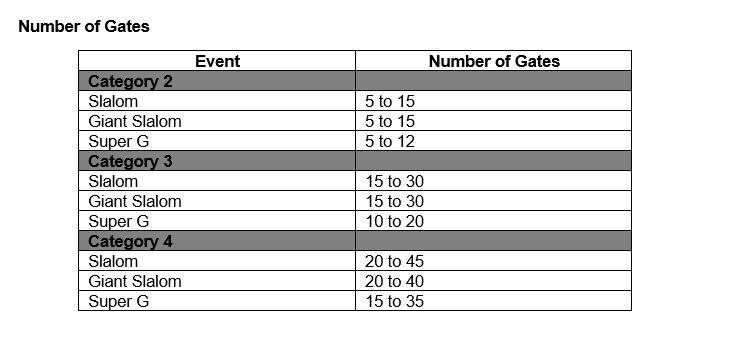Snowboarding Rules
Valid through 2027
*Addendums added since last rules update (also highlighted in yellow):
- Athletes must supply their own equipment at competition
- Alpine Ski athletes and Snowboarding athletes will compete on the same course
Special Olympics New Hampshire has created this set of rules based on the rules outlined by Special Olympics International as well as the International Ski Federation (FIS), which is the international governing body for Snowboarding, and the International Paralympic Committee (IPC), the international governing body for athletes with physical disabilities competing in Snowboarding.
These rules shall be used to govern all Special Olympics New Hampshire Snowboarding competition through the end of 2027 when we next review these rules.
Events Offered
- Category 1
- 10 M Walk
- 10 M Glide
- 25 M Super Glide
- Category 2 With Support (tethered/assisted)
- Slalom
- Giant Slalom
- Super Giant Slalom (Super G)
- Category 2
- Slalom
- Giant Slalom
- Super Giant Slalom (Super G)
- Category 3 With Support (tethered/assisted)
- Slalom
- Giant Slalom
- Super Giant Slalom (Super G)
- Category 3
- Slalom
- Giant Slalom
- Super Giant Slalom (Super G)
- Category 4
- Slalom
- Giant Slalom
- Super Giant Slalom (Super G)
Registration
- An athlete may only compete in one category above.
- An athlete may compete in up to three events (not including time trial).
- Athletes participating in with support must register for with support (Tethered/assisted).
Divisioning
- Each category will be divisioned separately.
- Divisions will be created using only ability level (not age or gender).
Equipment
- Athletes must supply their own equipment for competition.
- A helmet approved by the International Ski Federation (FIS) is required on all forerunners and competitors in official training and competition for all ability levels in all events. Soft ear protection is only permitted for helmets used in Slalom. All helmets must carry an approved tag (FIS sticker). Competitors without an approved tag will not be allowed to start. (FIS rule 707)
- Competitors must wear assigned bib in a position visible to officials at all times. The bib shall be worn over the athlete’s head, so the number shows on both their front and back. The bib is attached with two anchors, one on the left, and the other on the right side of the athlete, connecting the front and back.
Competition
Course Layout
* Due to course availability and number of athletes competing, Alpine Ski athletes and Snowboarding athletes will compete on the same course*
Gates and Poles
- Super Glide
- The Super Glide shall be set by alternating blue and red gates.
- Slalom
- One slalom pole, the turning pole, shall be used to establish a slalom gate. A Single Pole Slalom has no outside pole except for the first and last gate.
- Giant Slalom and Super-G
- In Giant Slalom and Super-G, two sets of poles with a panel between constitute a gate.
- The first gate (or sets of gates) after the start should always be red
Category 1
10 M Walk

10 M Glide

25 M Super Glide

Categories 2-4


General rules
- All athletes must complete a course inspection prior to each of their events.
- All athletes must complete a time trial during the scheduled time allotment. Failure to do so will result in the athlete being placed in the top division within their category for all races.
- Finish time for both the Slalom and Giant Slalom competition is determined by the sum of two runs.
- Finish time for the Super Giant Slalom is the result of one run.
- A disqualified racer may have a second run, but they will run at the end of their division.
Race Procedure
- For all Special Olympics alpine events at each ability level, the start command shall be as follows: “5, 4, 3, 2, 1. GO!” The timer begins when the skier’s front boot crosses the start line, or when the electric timing wand is activated.
- Upon leaving the start line, athletes must pass the first gate as the course is set.
- Correct passage: A gate has been passed correctly when the competitor’s snowboard tip and both feet have passed by the gate. The start and finish lines are the same as a gate line.
- In the event a competitor removes a pole from its vertical position before the competitor’s snowboard tip and both feet have passed the gate line, the snowboard tip and feet must pass the original gate.
- The time stops when the competitor’s front boot passes the finish line.
Disqualification
In addition to failing to abide to the rules above, a competitor may be disqualified for the two-minute rule.
- Two-Minute Rule:
- If the competitor moves out of the general direction of the line of the course (fall, miss a gate, lose a ski, etc.), he/she shall have 2 minutes from the time of the deviation to re-enter the course.
- A competitor who fails to adhere to this 2-minute time limit, or receives assistance of any kind, shall be disqualified. Disqualification is determined by the Gatekeeper assigned to the gate closest to where the infraction occurred, and the Gatekeeper is responsible for timing.
